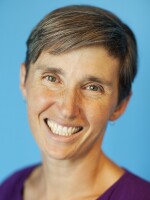

The German capital, Berlin, is in the middle of a makeover. After decades of being split between East and West, it was united when the Berlin Wall fell 17 years ago. The East is being renovated or rebuilt. Berliners say that's not just a physical change, but a political and emotional one, too.
One of the newest construction sites of the new Berlin is Alexanderplatz -- Alexander Square. It was a central meeting place during communist rule in East Germany. It's not very pretty right now -- all concrete and people in a hurry. Trains and subways from all directions stop here. Trolleys glide right through crowds of pedestrians.
The plan for Alexanderplatz is to surround it with eight high-rise office buildings. It's a plan East Berlin architect Bruno Flierl hates.
"This is, from the point of view of German unification, stupid and dangerous," he says. "It's occupation and not unification."
What Flierl really can't stand is that the high buildings will block the view of East Berlin's distinctive television tower -- a concrete stick with a big silver ball and an antenna on top. It was built as a symbol of East Germany's power.
In Flierl's view, Berlin is being rebuilt by the perceived victors -- the winners from the West. Like architect Hans Kollhoff, who designed the plan for a new Alexanderplatz from his offices across town.
"Now look, let's face it," Kollhoff says. The TV tower can be respected as a DDR (former East Germany) monument in East Berlin, but it cannot be respected by any means as a great piece of architecture."
Berlin's most contested redevelopment is Palace Square, which, for 500 years was home to a fortress turned royal residence. The East German government blew up the royal palace after World War II and built a new one -- the Palace of the Republic -- where the Communist Party held conferences, and ordinary people enjoyed subsidized entertainment.
Some Berliners want the whole royal palace back. But, so far, the plan is just to rebuild its walls, with modern buildings for arts and culture inside. Flierl says that bringing the palace back would further erase East Berlin while blindly honoring earlier times.
City planners say Berlin, where the two sides of the Cold War rubbed up against each other, is hard to knit together precisely because of history and emotions. But despite the fights and feelings, architect Kollhoff says the new mix of buildings is much more thoughtful than it could have been.
"It is still Berlin," Kollhoff says. "There's enough left of the East Berlin time, which you can recognize and locate. But, at the same time, there have been a lot of modern buildings going up to accomplish the needs of those people who live and work there, and who want to be in this place."
Copyright 2022 NPR. To see more, visit https://www.npr.org. 9(MDAzMjM2NDYzMDEyMzc1Njk5NjAxNzY3OQ001))







